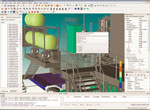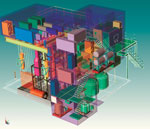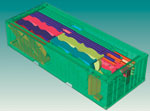
Developing algorithms that can optimise the means by which sweets, laundry detergents and pharmaceuticals can be packaged might not initially seem very relevant to companies involved in the decommissioning of nuclear power plants.
But based on his past research, in which he created algorithms for exactly such purposes, Richard Williams, professor of mineral and process engineering at Leeds University, has now helped to develop a software package based on similar principles that can help contractors plan the safe decommissioning of nuclear facilities.
The original software Williams developed uses algorithms to simulate how particles of any shape or size behave when they are placed into a container.
He developed the software after realising that most existing software packages used to solve such packing problems could only handle simple and regular-shaped objects - a scenario that did not reflect real-life problems accurately enough.
When this earlier packaging software was trialled in the food and pharmaceuticals industry, a number of manufacturers expressed an interest in purchasing it, and so Williams and his team commercialised the product through the formation of the Leeds University spin-out company Structure Vision.
The software can analyse the most effective way that the nuclear plant can be dismantled and packaged
But Williams also realised that there was a bigger potential application for the algorithms that he had developed. Because he had previously worked with engineers at BNFL, he was especially familiar with the problem of decommissioning nuclear power plants and realised that the software could play an important role there too.

Now the algorithms have been incorporated into a new software package that has recently been launched by Structure Vision. Called NuPlant, it enables planners to work out the optimum way to break up and package contaminated equipment, reducing the number of long-term storage containers needed for the task.
Williams said that, in use, the three-dimensional structural diagrams that detail the specific process equipment in the nuclear plant that is due to be cut apart during the decommissioning process must first be imported into the software.
Such data can be extracted from existing two-dimensional documentation, which can then be transformed into three-dimensional plant structural diagrams.
Alternatively, where records of the equipment in older plant may be missing or inadequate, a three-dimensional map can be created from a laser survey of the plant, a process that captures exterior surface models of the process equipment that can then be used as the basis from which a three-dimensional map of the process pipelines and process reactors can be reconstructed.
Williams said that the software has been validated with a number of third parties, including Energy Solutions, Nuvia and LLWR, and in most of the trials that have been undertaken, the companies have either been able to provide a three-dimensional design data set or two-dimensional drawings of the plant that can then be converted to three-dimensional images.
The system allows users to scrutinise methods by which the equipment can be cut apart prior to storage
Once the data has been captured by the system, the software can analyse the most effective way that the plant can be dismantled and then make suggestions as to the most efficient way that the waste can then be packaged. That is important because independent commercial contractors have estimated that just packing such waste resourcefully could lead to literally millions of pounds being saved, according to Williams.
In dismantling any item from a nuclear power plant, the software allows a user to scrutinise a number of different methods by which the equipment in the plant can be cut apart prior to storage.
The software can propose the number of cuts to be made to dismantle the equipment, in what order they should be made, as well as how the material would best fit into containers and how any additional content in the containers could be optimally positioned.
Contractors can then apply their own costing models to examine the outlay incurred in decommissioning specific equipment in the plant in the particular fashion suggested by the dismantling protocol options presented by the software.
’One of the big cost issues involved in decommissioning a nuclear facility relates to the number of personnel required to perform such operations and the time it takes them to do so. If the process takes longer, or requires more human presence than expected, then a heavy cost penalty may be incurred,’ said Williams.
’But by using our software, in conjunction with their own costing models, it is possible for a contractor to work out the most effective, cost-efficient route for dismantling the plant.’

It is also possible for users of the software to assign specific properties to the material that is being cut apart and packaged - an important consideration given the lifetime of much nuclear waste. Typically, in the case of a nuclear plant, this consists of a description of the type of the material, the type of waste it is, and the level of radiation it emits.
Report generation is another important feature of the software, and Williams said that the specific technical parameters that the software generates were defined by Structured Vision after consultation with its validation partners who provided invaluable input through an advisory group as to the nature of the information that they required.
Typically, the reports contain an inventory of the contents of a storage container, listing the number of components that are in it, the weight distribution, the radiation distribution, and details about the properties of the cement mix that it is filled with to provide shielding from radioactivity.
Williams said that prior to the development of the NuPlant software, such a detailed inventory was previously unavailable to contractors working on decommissioning and that such reporting is critical for regulatory reasons.
In the future, Williams sees an important use for Structure Vision’s software in new nuclear build too, where it will enable designers to envisage how nuclear plants that are currently being designed will be able to be decommissioned most cost-effectively and safely when they have reached the end of their useful life. As such, the company is actively seeking to work with individuals involved in such programmes to ensure that its software can play an important role early on in the design cycle.
The key facts to take away from this article
-NuPlant software uses algorithms to solve packing problems
-It simulates how particles behave when placed into a container
-It also analyses the most effective way that a plant can be dismantled
-The software could also one day play a key role in new nuclear build




Project to investigate hybrid approach to titanium manufacturing
What is this a hybrid of? Superplastic forming tends to be performed slowly as otherwise the behaviour is the hot creep that typifies hot...